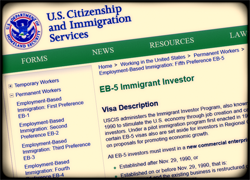America is trying to improve the high school graduation rate, which is a ratio between those entering as freshmen and those leaving with a diploma. The national average in 2010, according to Department of Education statistics, was 78.2 percent.
The roughly comparable figure for the immigrant investor (EB-5) program is about 50 percent for the most recent time period. Whereas high school runs for four years, the waiting period in EB-5 is only two years, but the "graduation rate" is much lower. Here is how it works:

The incoming (alien) freshmen in the EB-5 program tell the government that they have invested, or are in the process (a slippery concept) of investing $500,000 in Department of Homeland Security-approved, but not guaranteed, projects, which are supposed to produce 10 full-time U.S. jobs. The aliens file a DHS form (I-526) and then, if approved, an investor, the investor's spouse, and all their under-21 children are given conditional resident (CR) cards.
The CR cards are good for two years and allow the possessor to live and work legally in the United States. If all goes well, and if the aliens are still interested in being in the United States at the end of the two years, the aliens can ask that the "conditions be removed" and that they be granted permanent green cards. This they do by filing yet another DHS form, the I-829.
If the EB-5 program were working as well as our high schools — not a very rigorous standard — one would expect that about four out of five (approved I-526) investors would get an I-829 approval, and thus a green card.
But no. When you compare the number of approved I-526s in a given year to the number of I-829 approvals two years later, the ratio is only 49.3 percent. (See table below.) This comparison is for federal fiscal years 2008 through 2012 for the I-526 step and federal fiscal years 2010 through 2014 for the I-829 approvals. (We used an estimate for the final quarter of federal FY 2014, which concludes on September 30.)
So only about half the CRs are converted to green cards. Why is this the case? The agency is not helpful, but knowledgeable people suggest three basic reasons for the sharp drop-off:
- Some aliens lose interest between steps one and two and decide that they do not want to live in the United States after all.
- It turns out that some of the aliens do not qualify for the green card. Maybe the alien did not complete the investment; maybe DHS found out that something was wrong with the application that had not been apparent earlier (e.g. the $500,000 was not actually the alien's or the money was secured in a shady way.)
- The basic investment turned sour and the alien lost both green card and the investment. This is not supposed to happen, but it has been widely reported that it has occurred in at least one of the EB-5 scandals in South Dakota in recent years.
the EB-5 Visa Program:
The raw numbers used in the table below are drawn from official USCIS sources, but the two-year comparison and the related comments are from the Center for Immigration Studies.
I hope that this piece of realistic news is conveyed to the rich Chinese who buy up the lion's share of these EB-5 investments. I assume that many of them do not know, and are not being told, that they have a 50-50 chance of becoming an EB-5 dropout.
| Fiscal Year |
Conditional Resident Approvals |
Fiscal Year |
Green Card Approvals |
Green Cards as a Percentage of Conditional Resident Approvals |
||
| | | | | |||||
| 2008 | 642 | | | 2010 | 274 | | | 42.70% |
| | | | | |||||
| 2009 | 1,265 | | | 2011 | 1,067 | | | 84.30% |
| | | | | |||||
| 2010 | 1,369 | | | 2012 | 736 | | | 53.80% |
| | | | | |||||
| 2011 | 1,571 | | | 2013 | 844 | | | 53.70% |
| | | | | |||||
| 2012 | 3,677 | | | 2014 | 1,278 (est.)2 |
| | 34.8% (est.)2 |
| | | | | |||||
| 2013 | 3,699 | | | 2015 | n.a. | | | n.a. |
| | | | | |||||
| 20143 | 2,7074 | | | 2016 | n.a. | | | n.a. |
| | | | | |||||
| FYs 2008-2012 | 8,524 | | | FYs 2010-2014 | 4,199 | | | 49.30% |
Sources: USCIS; see here and here. Calculations by the Center for Immigration Studies.
1 Data are lagged because of the two-year wait between the issuances.
2 Projected on the assumption that the first three quarters rate will continue for the full year; alternately, if the projection is that the high rate of third quarter approvals were to be equaled in the fourth quarter, the two cells for 2014 GC approvals would show 1,466 and 39.9 percent, respectively. The odds are that the higher set of estimated numbers for the full FY 2014 are better than the lower ones.
3 First three quarters.
4 A straight line projection from the first nine months of FY 2014 for the full year would be 3,609.
